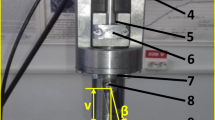Abstract
EXPERIMENTS have been conducted on thin-walled tubes of an aluminium–magnesium alloy (3.08 per cent magnesium, 0.3 iron, 0.44 manganese, 0.18 silicon) under conditions of simple shear. Two tubes aligned on a common axis are used for each test, the torque being applied through a disk connected to both tubes. The assembly is mounted in a thermostatically controlled enclosure, and to avoid any possible errors due to inertial effects associated with the dynamic stress component, the torque is applied through a spring system. A simple electrical device is used to maintain a constancy of torque (within 1 part in 5 × 103) as the disk rotates during creep. The creep curves are recorded continuously by a photoelectric follower and associated recorder (a ‘Graphi-spot’) which traces the movement of a spot of light reflected from a mirror mounted on the shaft of the torque disk.
Similar content being viewed by others
References
Greenwood, J. N., Proc. Amer. Soc. Test Mat., 49, 834 (1949). Kennedy, A. J., Intern. Conf. Fatigue of Metals, Inst. Mech. Eng. (1956). Meleka, A. H., and Dunn, G. B., J. Inst. Metals, 88, 407 (1960).
Author information
Authors and Affiliations
Rights and permissions
About this article
Cite this article
KENNEDY, A. Characteristics of Fatigue-activated Creep in an Aluminium–Magnesium Alloy. Nature 195, 898–899 (1962). https://doi.org/10.1038/195898a0
Issue Date:
DOI: https://doi.org/10.1038/195898a0
- Springer Nature Limited





